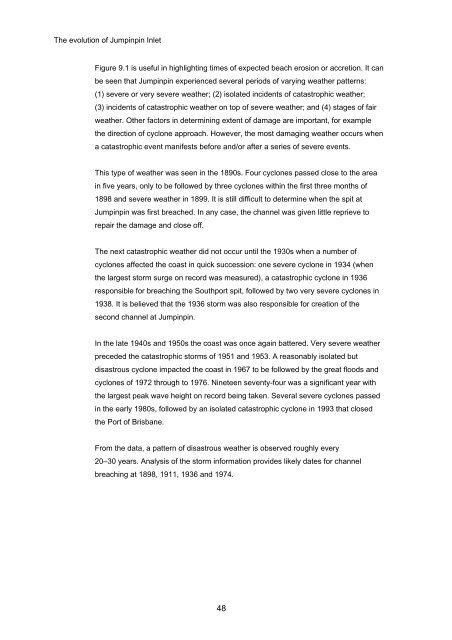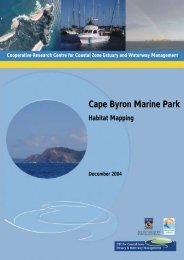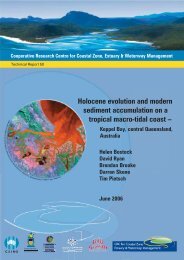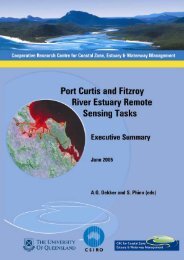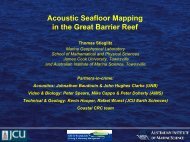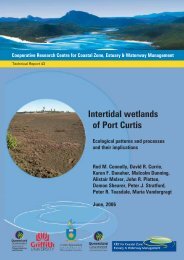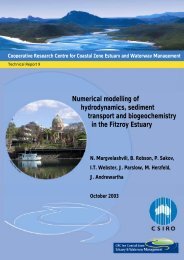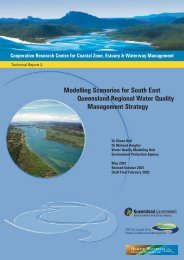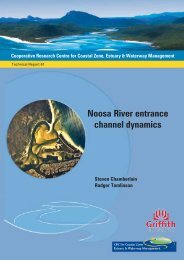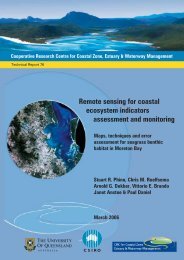The evolution of Jumpinpin Inlet - OzCoasts
The evolution of Jumpinpin Inlet - OzCoasts
The evolution of Jumpinpin Inlet - OzCoasts
You also want an ePaper? Increase the reach of your titles
YUMPU automatically turns print PDFs into web optimized ePapers that Google loves.
<strong>The</strong> <strong>evolution</strong> <strong>of</strong> <strong>Jumpinpin</strong> <strong>Inlet</strong><br />
Figure 9.1 is useful in highlighting times <strong>of</strong> expected beach erosion or accretion. It can<br />
be seen that <strong>Jumpinpin</strong> experienced several periods <strong>of</strong> varying weather patterns:<br />
(1) severe or very severe weather; (2) isolated incidents <strong>of</strong> catastrophic weather;<br />
(3) incidents <strong>of</strong> catastrophic weather on top <strong>of</strong> severe weather; and (4) stages <strong>of</strong> fair<br />
weather. Other factors in determining extent <strong>of</strong> damage are important, for example<br />
the direction <strong>of</strong> cyclone approach. However, the most damaging weather occurs when<br />
a catastrophic event manifests before and/or after a series <strong>of</strong> severe events.<br />
This type <strong>of</strong> weather was seen in the 1890s. Four cyclones passed close to the area<br />
in five years, only to be followed by three cyclones within the first three months <strong>of</strong><br />
1898 and severe weather in 1899. It is still difficult to determine when the spit at<br />
<strong>Jumpinpin</strong> was first breached. In any case, the channel was given little reprieve to<br />
repair the damage and close <strong>of</strong>f.<br />
<strong>The</strong> next catastrophic weather did not occur until the 1930s when a number <strong>of</strong><br />
cyclones affected the coast in quick succession: one severe cyclone in 1934 (when<br />
the largest storm surge on record was measured), a catastrophic cyclone in 1936<br />
responsible for breaching the Southport spit, followed by two very severe cyclones in<br />
1938. It is believed that the 1936 storm was also responsible for creation <strong>of</strong> the<br />
second channel at <strong>Jumpinpin</strong>.<br />
In the late 1940s and 1950s the coast was once again battered. Very severe weather<br />
preceded the catastrophic storms <strong>of</strong> 1951 and 1953. A reasonably isolated but<br />
disastrous cyclone impacted the coast in 1967 to be followed by the great floods and<br />
cyclones <strong>of</strong> 1972 through to 1976. Nineteen seventy-four was a significant year with<br />
the largest peak wave height on record being taken. Several severe cyclones passed<br />
in the early 1980s, followed by an isolated catastrophic cyclone in 1993 that closed<br />
the Port <strong>of</strong> Brisbane.<br />
From the data, a pattern <strong>of</strong> disastrous weather is observed roughly every<br />
20–30 years. Analysis <strong>of</strong> the storm information provides likely dates for channel<br />
breaching at 1898, 1911, 1936 and 1974.<br />
48


